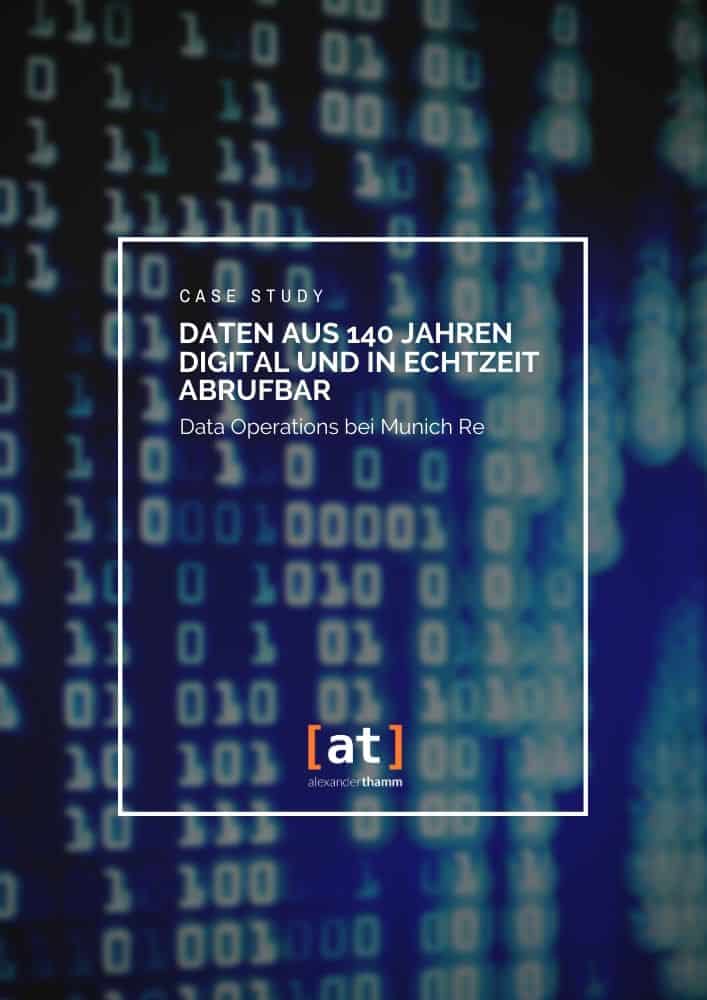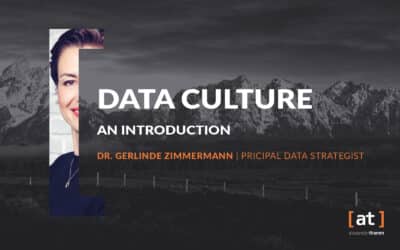We have identified the 10 top big data trends in the insurance industry and present exciting trends in two parts. The first part is about future trends in marketing and sales. The second part looks at process improvement trends in the insurance industry.
In the use of big data and data science, the successful use cases are increasingly crystallising. The critical factor for the use of big data and data science is still the data situation. Many companies, for example, have to realise after the initial exploration that they first have to digitise parts of their data, dismantle data silos or collect more data.
Big data analyses are increasingly becoming the focus of data-driven business models, especially in the insurance industry. With Data Science customers and prospects can be addressed in a more targeted manner and their customer journey can be controlled. Innovative big data approaches make it possible to exploit the optimisation potential of the usual insurance processes.
Inhaltsverzeichnis
1. AI-powered cloud platforms
AI-supported cloud platforms are taking the place of on-premise solutions. Big data analyses are increasingly becoming a standard tool. For example, in the assessment of risks, damage analysis or for customer segmentation - the Analysis of large amounts of data brings decisive advantages here. It is not only crucial that all relevant data can be accessed across locations. Due to the ever-increasing volumes of data, it is necessary to organise and provide them optimally.
AI solutions are increasingly playing an important role in this. Cloud services that combine AI and Machine Learning The data processing methods that companies use to process data will therefore determine their performance and competitiveness in the future.
2. simplified underwriting with predictive analytics
A time-consuming and correspondingly cost-intensive task when taking out an insurance policy is the precise risk assessment. For this are Very detailed Information necessarywhich so far still have to be collected with extensive questionnaires. As a rule, this process is not yet fully digitalised. Depending on the type of insurance, it is still a lengthy, partly analogue process.
In the case of health and supplementary long-term care insurance, for example, questionnaires on pre-existing conditions have to be filled out, medical examinations have to be carried out and, in some cases, laboratory tests have to be evaluated. In order to proceed more efficiently here, it is worthwhile to categorise the customers.
Low-risk clients will be included in Future with predictive Algorithms identified using extensive profile and behavioural data. These customers can thus be offered a simplified process for risk assessment. This measure improves both the customer experience and internal processes. Predictive analytics thus simplifying the policy process.
3. AI-supported claim management
Another elaborate process at Artificial intelligence in the insurance industry represents the Evaluation from Insurance claims The assessment requires information from heterogeneous, partly analogue customer documents. The assessment requires information from heterogeneous, partly analogue customer documents. This presents insurers with two challenges: On the one hand, analysing the documents is very time-consuming, and on the other hand, digitising them is very time-consuming.
One solution to this problem is the use Artificial Intelligence (AI)more precisely, the use of machine learning. Learning recognition algorithms help insurance companies classify document types and identify particularly important sections.
Digital image processing and text recognition algorithms also open up great automation potential when it comes to evaluating analogue documents. AI-supported claim management thus leads to a greater Efficiency in supplementary claim management.
4. customer clustering for an optimal customer approach
Another important representative of Big Data trends is Customer Clustering. Whereas demand forecasting is about predicting future events, the goal of customer clustering is a Better understanding of the available data. Another important element of a targeted and optimised customer approach is the identification of relevant customer groups. Determining the criteria for meaningful customer segmentation for sales and marketing purposes is often difficult.
In this case, so-called "Unsupervised Machine Learning" techniques are used. Here, an algorithm recognises similarities in large data sets without being given specific target values from outside, as in demand forecasting.
For this purpose, a combination of inventory data and external data is used in which commonalities are to be identified and grouped (clustering). The results of this process lead to a Customer segmentationwhich can be used to determine the respective Addressing the customer group optimally.
5. customer lifetime value
It is a truism that our lives can change quickly and seriously. Today, this sentence is all the more true because life circumstances are even more likely to change massively. Hardly any of the younger generations will have a single job for the rest of their lives.
This becomes a difficult challenge when insurance companies offer products that accompany their customers throughout their lives. This makes it all the more important today, Customer potential for the entire life cycle to be assessed.
The calculation of customer lifetime value helps insurance companies in this situation: customer-specific profiles enable the estimation of customer value and justify investments in their long-term loyalty. Inventory data is not sufficient to build such profiles. As a rule, external data resources must be used to enrich the data accordingly. In this way, an accurate customer valuation can be achieved on the basis of more precise profiles.
6. customised demand forecasting: life-changing events
Customer-specific demand forecasts are suitable for the sale of life insurance policies, for example. In the ongoing low-interest phase, the variety of life insurance policies is increasing in order to keep them attractive. Moreover, these are purchased at very irregular intervals - sometimes only once in a lifetime.
This makes it all the more important for insurers and their marketing and sales departments to crucial Moments to recognise in lifein which a life insurance policy becomes interesting. The decision to buy often follows life-changing events such as reaching a certain age, marriage or the birth of a child.
7. property insurance: the smart home concept changes the requirements for modern insurance policies
Besides energy savings, security in a smart home is the most important argument for customers. This represents a great opportunity for insurance companies. They can Home surveillance services with residential building insurance and thus offer their customers a coherent overall package. Intelligent algorithms can detect unusual events by identifying anomalies in sensor data that deviate from regular patterns.
In this way, the occurrence of damage can early indexed and, in the best case, even avoided. For example, sensors in water pipes monitor the pressure and water flow. Damage to the pipe that results in a permanent or large leakage of water can thus be quickly detected and a Water damage avoided become.
In addition, insurance companies can offer their customers a mobile app that informs the customer about the risk of damage - such as from certain weather events or a cooker that has been switched on.
Individual supplementary insurances can be offered within this framework and the first communication in the event of a claim can take place directly via the app. The possibilities for offering customers additional services are manifold: Equally conceivable are "Assistance Services" such as the automated call to a repair service.
8. health care and health insurance: the Healthy Living and Fraility Care concept
In the context of healthcare provision and insurance, more and more solutions are being developed that are based on new technologies and Data analyses based. The so-called "healthy living concept" combines health insurance and disease prevention services.
New technologies and data science go hand in hand here: healthcare wearables such as fitness trackers or smart watches generate biometric datawhose analyses provide information about the state of health of its wearers.
Wearables can also register, for example, whether a patient has not moved for a long time, thus providing an indicator of their state of health. The Fraility Care concept, which focuses on the health care of elderly, frail or weak people, also fits into this context.
Medical devices and sensors also provide the Basis for remote diagnosis. As soon as a potentially health- or even life-threatening event occurs or is even imminent, preventive countermeasures can be taken. Sensors can, for example, not only register an irregular heart rhythm, but also trigger a signal that informs the responsible nursing staff, relatives or doctors.
9 AI and Deep Learning in Medicine: Second Medical Opinion
Various studies come to the conclusion that on average 15 % - 20 % of all diagnoses (source: spiegel.de) are wrong. Due to the great advances in the field of Artificial intelligence in medicine in recent years, the Misdiagnoses to be reduced in future. This leads us directly to our ninth data science trend: Second Medical Opinion thanks to intelligent algorithms that can compare many millions of cases in a few minutes or include image and text databases with existing diagnoses.
In future, doctors will be able to substantiate their diagnoses or have them checked. In this way, patients have the opportunity to obtain a second opinion with little effort. This increases the certainty of receiving the right diagnosis in time.
Second Medical Opinion means enormous savings potential for insurance companies. Not only can the number of incorrect treatments be reduced through the use of AI, but the associated legal disputes and claims for damages are also drastically reduced.
10. motor vehicle insurance
Another important representative of the data science trends are telematics tariffs. In one Connected Car Numerous sensors are installed which, among other things Information about the driving style of the driver. Older vehicles can also be upgraded to a networked car with the help of a box that supplies the corresponding data.
At Telematics tariffs in the insurance industry insured persons agree to transmit data about their driving behaviour to an insurance company. The insurance company in turn offers reduced rates or premiums if the data indicates safe driving behaviour. For this purpose, for example, factors such as compliance with maximum speeds and braking and acceleration behaviour are assessed, but other factors such as usage and standing times are also included.
Especially Novice drivers who have to pay higher premiums due to their risk group can benefit from telematics tariffs - even in two ways. On the one hand, their premiums decrease when they transmit their data to the insurance company. On the other hand, they become accustomed to a safe driving style and thus contribute overall to the Increase the safety of road traffic at.
Conclusion
The trends for the insurance industry are intended to reflect the broad spectrum in which massive changes have already occurred and will continue to occur in the future. Digitalisation and the development of new, digital technologies represent a great opportunity for insurance companies.
This results in advantages both for the insurance companies themselves, but also for their customers: Risks can be calculated better than ever before and adjust prices for data-driven products accordingly.
In this context, data provides information about lifestyles and opens up potential for improvement. The Big Data trends in the insurance industry show that they can make a valuable contribution to mastering the digital transformation in order to remain competitive in the future.

Case Study:
Data Operations at Munich Re










0 Kommentare